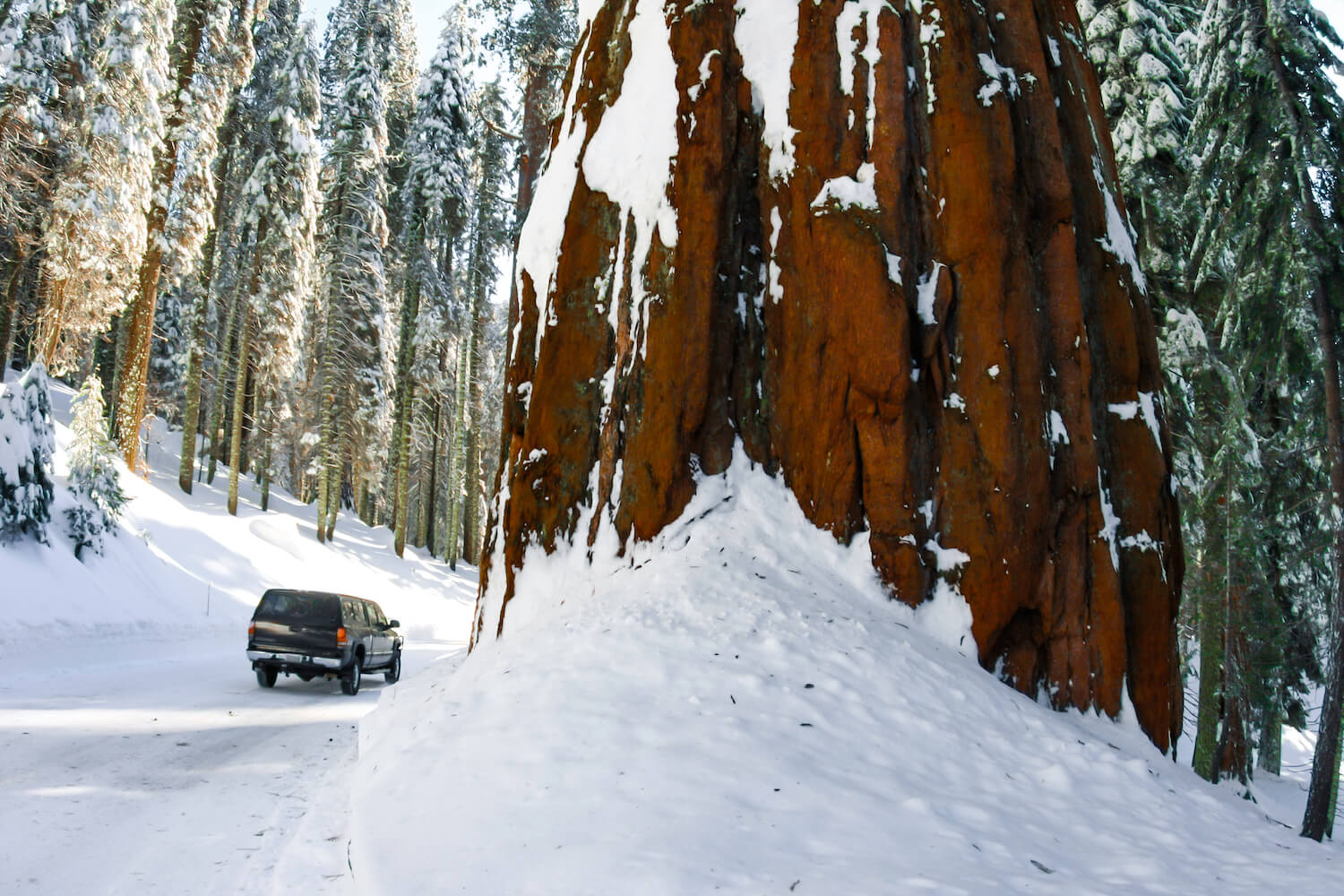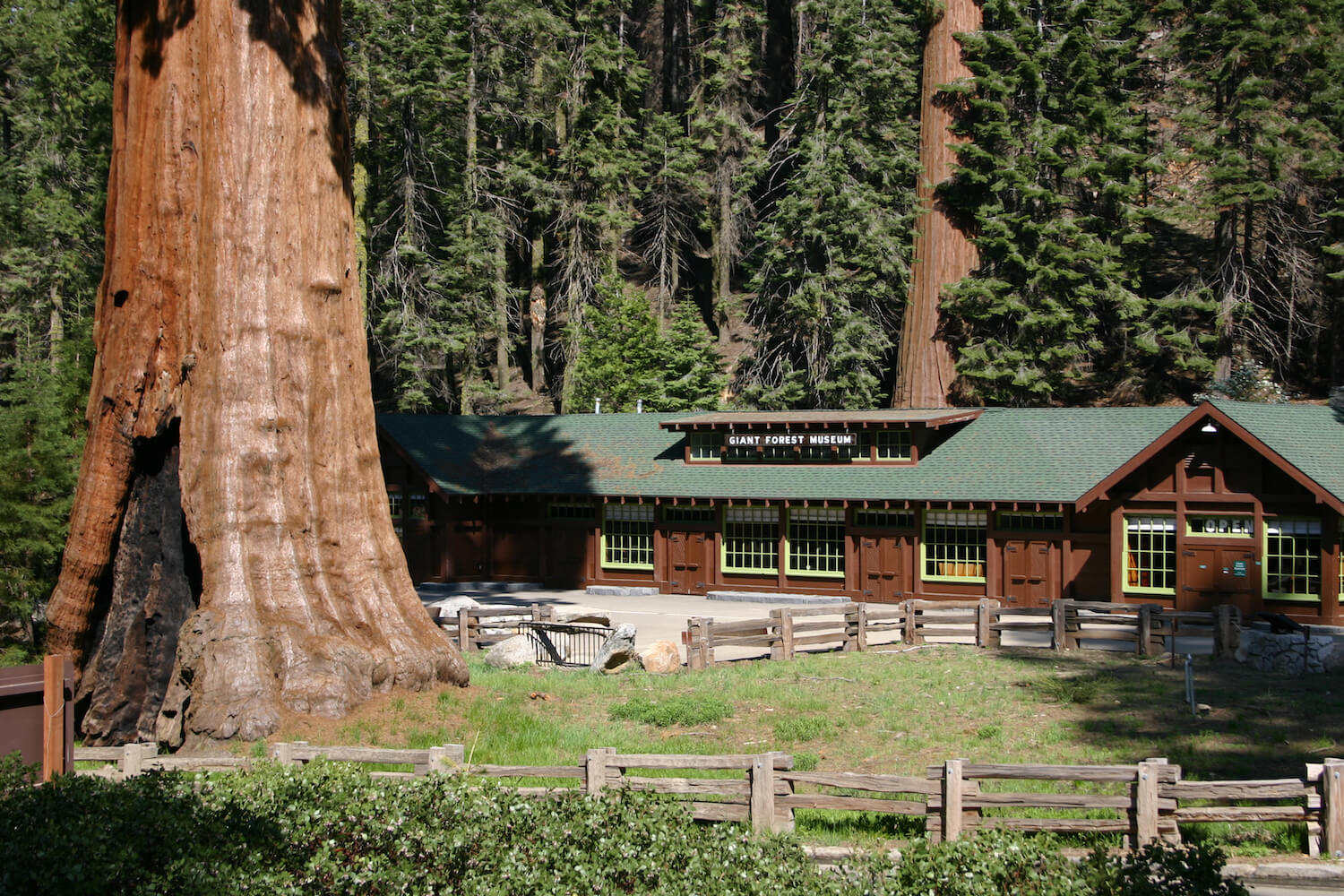Sequoia National Park covers an expansive 1,300 square miles and is home to Mount Whitney, the tallest peak in the lower 48 of the United States. With roaring mountain rivers, granite peaks, an extensive backcountry, and signature Giant Sequoia trees, Sequoia National Park brings in over one-million annual visitors to experience its beauty.
If you’re looking for the only place in the world to feel the immense power of these storied trees, then gas up your RV and hit the road. But before you do, here’s what you need to know about RVing in Sequoia National Park.
Table of Contents
ToggleWhy Visit Sequoia National Park in an RV?

Have you ever wanted to walk among giants? California’s two-for-one national park duo of Sequoia and Kings Canyon lets you venture into a land of otherworldly trees that almost seem too grand to be real. And with these giants growing only within a 60-mile area high in the Sierra Nevada mountains, it’s the only place you’ll be able to experience their power.
Sequoia National Park is easily accessible in under four hours from Los Angeles, Sacramento, and San Francisco and can easily be looped into a National Parks road trip with Yosemite to the North or Death Valley to the Southeast.
Because Sequoia and Kings Canyon National Parks are in close proximity, having an RV for your visit to these parks allows you to easily bounce back and forth. You can easily go from seeing General Sherman Tree on the Sequoia side of the park to the Zumwalt Meadow on the Kings Canyon side on the same day.
When to Visit Sequoia National Park
Sequoia National Park is open year-round, but seasonal closures can impact what is and is not available to visitors during colder seasons. For this reason, summer is typically the peak season for exploring the park. However, there’s plenty to do if you plan to visit in the offseason.
Sequoia National Park in the Spring

Spring visitors to Sequoia National Park should prepare for winter-like conditions and some road closures. So, make sure you’ve equipped your RV with tire chains. You’ll be able to explore the giant sequoia groves while still dusted in white snow, but at milder temperatures than winter in the Sierra Nevada range. In mid-to-late spring, you’ll be able to enjoy wildflowers on display in many of the meadows of Kings Canyon.
Sequoia National Park in the Summer

Summer is the peak time for Sequoia National Park, with the temperatures reaching mild highs in the low to mid-70s and dipping down to chilly evenings and early mornings in the mid-40s. Be prepared that some of the more popular destinations like General Grant Tree, General Sherman Tree, and Tunnel Log may have waits to get in for those iconic photographs.
Sequoia National Park in the Fall

Fall offers similar conditions to the spring season, with season closures and early snows. You’ll trade out the wildflower blooms for some fall foliage from some of the park’s trees, but if the signature reds, oranges, and yellows of fall are what you are looking for, we recommend saving Sequoia for another time of year and heading over to Acadia National Park for an autumn trip.
Sequoia National Park in the Winter

Winter-loving adventurers can enjoy activities like cross-country skiing and snow showing among Sequoia’s giant groves in the winter months. Be prepared for frequent road closures and restrictions during this season, as temperatures tend to hover in the mid-30s during the day and get as low as the teens overnight.
Where to Stay

Between Sequoia and Kings Canyon, there are nine RV-friendly campgrounds, but only two of those are open year-round, and only Dorst Creek has designated RV-specific spots.
Here are your in-park camping options:
- Potwisha Campground: Open year-round with a 24-foot max RV length.
- Lodgepole Campground: Open Memorial Day thru Thanksgiving with rolling closures beginning in September; 40-foot max RV length.
- Dorst Creek Campground: Open July 4th thru September with 33 RV-only spots: accommodates RVs of all lengths.
- Azalea Campground: Open year-round with a 47-foot max RV length.
- Sunset Campground: Open Memorial Day thru Labor Day with a 30-foot max RV length.
- Crystal Springs Campground: Open July 4 thru Labor Day with some Memorial Day availability; 25-foot max RV length.
- Sentinel Campground: Open May thru Veteran’s Day with an 82-foot max RV length.
- Sheep Creek Campground: Open Memorial Day thru September with a 30-foot max RV length.
- Moraine Campground: Open Memorial Day thru Labor Day; accommodates almost all RV lengths.
Staying Outside the Park

If you are looking for campgrounds with RV hookups near the park, you can find several Good Sam parks within a two-hour drive of the park entrance.
- Lemon Cove Village RV Park: Located in Lemon Cove, CA, about 27 minutes from the Foothills Visitor Center.
- Sun & Fun RV Park: Located in Tulare, CA, about one hour from the Foothills Visitor Center.
- Kings River RV Resort: Located in Kingsburg, CA, about 70 minutes from the Foothills Visitor Center.
Invest in a Good Sam Membership and save 10% on nightly stays at Good Sam Campgrounds.
Tips for your Camping Stay

- Reservations can be made through Recreation.gov up to one month before your stay.
- Here are your links to the reservation sites for the campgrounds above:
| Potwisha Campground | Lodgepole Campground | Dorst Creek Campground |
| Azalea Campground | Sunset Campground | Crystal Springs Campground |
| Sentinel Campground | Sheep Creek Campground | Moraine Campground |
- None of the campgrounds have RV hookups, so be sure to prep your RV prior to making your way to your campsite.
- Each park campsite has a fire ring, picnic table, and food storage box.
- Check the official map to see where the campgrounds are located within the park.
- If you bring a generator, operating hours are from 9 am to 9 pm in most campgrounds. Dorst Creek and Lodgepole are the exceptions, where the generator hours run from 8-11 am and 5-8 pm.
- You’ll find places to dump your RV waste at Dorst Creek, Lodgepole, and Potwisha campgrounds.
- Check fire restrictions before your visit, even if camping at higher elevations. Consider bringing a propane firepit instead of having a wood-burning fire.
How to Get Around Sequoia National Park

Sequoia National Park covers a large area and is most accessible by car. All major attractions can be found on paved roads, but because of seasonal snow, you’ll need to check the park service website ahead of time to ensure routes are open.
You can enter the park from the south from Three Rivers or from the north via highway 180. There’s one key thing to remember as you plan which route to choose when visiting Sequoia National Park. How long is your vehicle?
If you are planning to enter from the south, the National Park Service recommends a maximum vehicle length of 22 feet on Generals Highway between Potwisha Campground and the Giant Forest Museum. This path is only suited for compact class B RVs.
Do you have a bigger RV and still want to explore the park? No problem. Come in on Highway 180 from Fresno, CA. Bring a smaller vehicle for your day-to-day travels, and you’ll still be able to access everything Sequoia National Park offers.
A free park shuttle runs from Wuksachi Lodge to Giant Forest Museum, typically open throughout the summer and over some holidays like Thanksgiving and Christmas, pending road conditions.
Places to Go
With over 600 square miles to explore, there’s no shortage of adventures for all accessibility levels. Paved paths to landmarks like the Generals Sherman and Grant trees allow every visitor to experience the park’s magic.
Backcountry passes to the John Muir, and Pacific Crest Trails let seasoned backpackers venture into the lesser-visited areas of wilderness. Here are some sites to visit in Sequoia National Park.
General Sherman Tree

Standing as a sentinel for over an estimated 2,200 years, the General Sherman Tree is the largest single-stemmed tree in the world. Only a short half-mile walk on a paved trail, the General Sherman Tree in the Giant Forest sequoia grove allows explorers of all ages and fitness levels to experience one of the world’s natural wonders.
General Grant Tree

Second only to the General Sherman Tree, General Grant Tree is another easily-accessible Sequoia giant. Nicknamed the Nation’s Christmas Tree, you can find it along the paved 1/3-mile trail in Grant Grove. Check out Fallen Monarch while you’re there. It’s a hollowed-out giant sequoia trunk you can wander through to experience how large these trees are.
Giant Forest Museum

While you’re at the General Sherman Tree, be sure to stop in the Giant Forest Museum. You’ll be able to dive into the history of the area, the trees, and more. Be sure to get your National Parks passport stamped by one of the rangers while you’re there.
Crystal Cave

Discover what’s under the mountain scenery by stepping into Crystal Cave. Explore a half-mile of the marble cavern on this guided tour. Because the cave is popular, buy your tickets ahead of time and plan for about a half-day trip, including drive time. The hike to the cave entrance is steep and can be challenging for some visitors.
Zumwalt Meadow in Cedar Grove

Nestled in a more remote part of the park, Zumwalt Meadow is a peaceful place to take in the surrounding Sierra Nevada peaks. Take one of the side trails and venture along Kings River and Roaring River Falls. Check road closures before you go, as Highway 180 into Cedar Grove is only open from May thru October.
Boyden Cavern

Wanted to do a Crystal Cave tour but missed out on getting tickets? Boyden Cavern is equally worthy of exploration. This one is technically in the Sequoia National Forest between the two parks, but you’ll pass it on the way into Kings Canyon along Highway 180.
The walk up to the cave entrance is steep, but the rest of this guided tour is accessible. You’ll even get to experience a total blackout as guides turn off all lights allowing you to experience the same darkness its first explorers did.
Things to Do in Sequoia National Park
Whether you’re an active or passive explorer, this two-for-one park has everything from sightseeing to hiking to rock climbing and more.
Hiking

There are more than 100 maintained trails throughout the park, with elevation changes ranging from under 10 feet to over 18,000 feet. Some of the more popular trails include:
- Moro Rock Trail (0.5 mi)
- Tokopah Falls Trail (3.8 mi)
- Congress Trail (2.9 mi)
- Marble Falls Trail (7.8 mi)
- Lakes Trail (11.6 mi)
Fishing

Several mountain streams run through Sequoia and Kings Canyon, making these national parks great spots to fish. There are various river trout that anglers can try to catch, but remember that you will need a fishing license for anyone 16 years or older.
Backpacking

Explore more than 800 miles of maintained backcountry trails on a multi-day backpacking trip, for which you’ll need a Wilderness Permit. Plan ahead, as there are limited park services once you enter the wild. Come equipped with your gear, food, and bear-safe storage. You can reserve permits up to six months in advance during quota seasons.
Birdwatching

More than 200 species of birds call the Sierra Nevada mountains home or make their way through seasonally. Grab your binoculars, print out this checklist from the National Park Service, and see how many you can find.
Rock Climbing

Get a different point of view scaling the cliff faces throughout the park. Though not as well-known as climbs like El Cap in Yosemite, Sequoia and Kings Canyon have an abundance of granite mountains perfect for climbers of all skills.
What to Bring and How to Prepare

Because none of the campgrounds in Sequoia National Park have RV hookups, and there are only a few dump stations, be prepared for an off-grid experience.
- Food & Drink: There are seven restaurants in or near the park. If you need a resupply, stock up your camping cooler at a general store in Three Rivers or Hume Lake. If you’re looking for a cooler, check out RV.com’s review of the YETI Roadie 48.
- Wildlife Deterrents: Bears are native to the park, so ensure all food is stored safely away when unattended. Campsites have bear boxes but bring additional food storage for an extended stay. If you hit the trails, it’s always recommended that you have bear spray for your safety.
- Portable Power Station: Because the park doesn’t have electric hookups, a portable power station is a great addition to your camping setup. Check out RV.com’s review of the BioLite BaseCharge 1500 Portable Power Station.
- Hiking Gear: While many of the park’s most visited areas are paved, keep hiking gear on hand to easily explore the park’s trails. Sturdy boots protect your feet, water shoes are a must for creek crossings, and trekking poles provide balance on uneven terrain. If you plan to hike longer than 1 mile, bring a hydration pack with water to ensure you stay hydrated.
- Extra Layers: Even when visiting in the summer, Sequoia and Kings Canyon can get chilly overnight and early mornings. Light layers will help you stay warm during the chillier times and allow you to adjust as things warm up throughout the day.
- Generators: You are on your own with the power you provide, so you can be as advanced or primitive as you wish. It’s always good to have a generator as a backup just for emergencies.
- Extra Fuel: There are no service stations within the park, but you can fill up a portable gas can in nearby towns like Three Rivers and Hume Lake.
Brief History of Sequoia National Park

The Sierra Nevada Mountains have been home to indigenous nations since long before America was founded. Many of their descendants remain as stewards of the land today.
Sequoia is the United States’ second officially designated national park and gained its status on September 25, 1890, thanks to President Benjamin Harrison. It was the first park dedicated to protecting a living organism, the park’s namesake, the Giant Sequoia.
In 1940, Kings Canyon was added to the list of national parks by Franklin D. Roosevelt, and the two parks remain connected and maintained together. Over 95% of the park is classified as wilderness, meaning there are limited resources, services, and maintained trails.
But the wilderness still sees hundreds of hikers yearly along the John Muir and Pacific Crest Trails. Experienced hikers come from all over to summit the highest peak in the contiguous 48 states, Mt. Whitney, which stands at 14,505 feet.
The parks invite over one million annual visitors to walk among giants that have been standing as guardians of the High Sierras for over 2,000 years. And you and your RV are on the guest list to join them.
Plan your next trip to the national parks in an RV. Rent an RV, trade-in your RV, or buy a new or used RV and start traveling for less than $5 a day.
Have you ever visited Sequoia National Park? Share your advice in the comments below!









